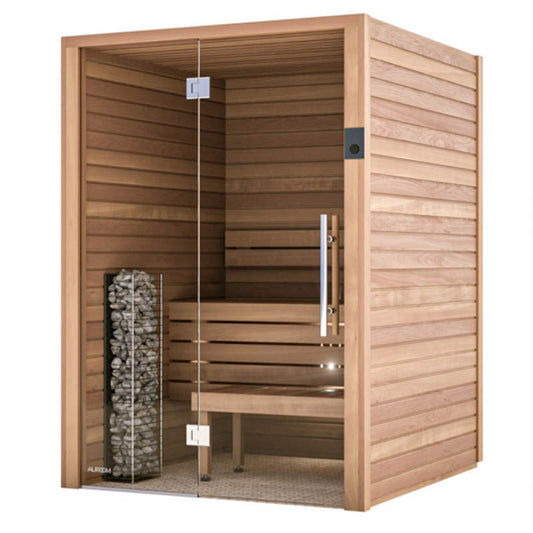The Ultimate Guide To Traditional Sauna
The Ultimate Guide To Traditional Sauna
Blog Article
Unknown Facts About Traditional Sauna
Table of ContentsExcitement About Traditional SaunaThe Only Guide for Traditional SaunaOur Traditional Sauna StatementsNot known Details About Traditional Sauna 4 Easy Facts About Traditional Sauna Explained
Energy savings is one point to think about for people who plan on using their sauna regularly. For a typical sauna, bathers generally require to wait on 30-40 minutes for the area to preheat prior to going into. Infrared saunas, on the other hand, generally reach their ideal temperature level in about 15 mins.That indicates that in an infrared sauna, bathers can start appreciating their sauna right away. One difference in between the two types of sauna that is often overlooked is the social experience. Standard saunas are typically large sufficient to fit multiple individuals and enable mingling. Infrared saunas are typically smaller sized in size, supplying more of a personal getaway and less of a social experience.

Traditional Sauna - Truths

Attempt a sauna today and find a few of the remarkable benefits for on your own!.

Elements such as warm resistance, preferred degree of detoxification, and general health and wellness must be thought about when choosing which kind of sauna to use. Infrared saunas are a sort of sauna that make use of infrared light to heat the body straight, as opposed to heating the air around the body like typical saunas.
Getting The Traditional Sauna To Work
The temperature in an infrared sauna is commonly reduced than in a traditional sauna, with temperatures ranging from 120F to 150F. Infrared saunas provide a variety of benefits that make them an appealing choice for those seeking to boost their wellness and well-being. Several of the advantages of infrared saunas consist of: Infrared saunas make use of reduced temperature levels than typical saunas, which can make them extra comfy for those that discover heats tough to endure.
Infrared saunas have actually been shown to aid the body remove toxic substances with sweating. Full Report Sweating can likewise assist to improve skin wellness by getting rid of impurities and dead skin cells.
The heat created by infrared saunas can assist to raise blood flow and boost flow. Infrared saunas have been shown to aid decrease anxiety and advertise leisure.
With their lower temperatures, deep infiltration, and series of health advantages, infrared saunas are a fantastic method to loosen up, take a break, and boost your general health. Traditional dry saunas have been around for centuries and are still preferred today. They are generally heated with wood, gas, or electricity and have low moisture levels.
What Does Traditional Sauna Mean?
There are a number of benefits to utilizing a typical completely dry sauna. Below are a couple of: Relaxation: The heat and reduced moisture in standard completely dry saunas can assist loosen up the muscular tissues and reduce tension levels. Cleansing: Sweating in a sauna can aid get rid of toxins from the body, which can enhance total wellness.
When it involves saunas, there are two main types of home heating approaches: traditional and infrared. Typical saunas use warmed air to warm up the body, while infrared saunas utilize infrared radiation to permeate the skin and warmth the body from within. Among the primary distinctions between both methods is the kind of warm they produce.
Typical saunas heat the air, which then heats up the body with convection. this hyperlink Infrared saunas, on the other hand, warm the body directly with radiation.
In terms of energy effectiveness, infrared saunas are normally a lot more reliable than typical saunas because they need much less power to run. They likewise heat up extra rapidly, so they can be utilized for much shorter sessions. Traditional Sauna. When it comes to the impacts on the body, both kinds of saunas have actually been shown to have benefits
The 9-Second Trick For Traditional Sauna
Infrared saunas have actually been shown to have comparable benefits, as well as potentially aiding with cleansing, skin health, and immune function. Generally, the choice between a conventional or infrared sauna comes down to personal choice and specific needs. Conventional saunas may be better for those that prefer greater temperatures and a much more extreme sweat action, while infrared saunas may be better for those who want a more mild and efficient heat therapy.
Both kinds of saunas offer special benefits and downsides that should be thought about prior to deciding. The option between an infrared sauna and a typical dry sauna largely depends on individual choice and the wanted advantages. Those who prefer a more comfy, lower temperature environment might choose an infrared sauna, while those who are trying to find intense warm and a conventional sauna experience might favor a traditional dry sauna.
Below are some security tips to keep in mind when utilizing infrared and typical completely dry saunas:: Saunas can cause too much sweating, leading to dehydration. It is necessary to drink lots of water in the past, during, and after my review here sauna sessions to remain hydrated.: It is recommended to restrict sauna sessions to 20-30 minutes to stay clear of getting too hot and dehydration.
Report this page